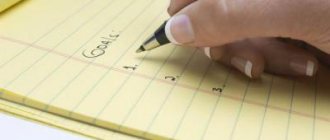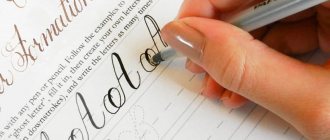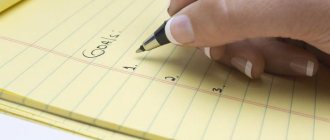Universal computerization has reduced to a minimum the need to use writing instruments. Most correspondence is typed on a computer keyboard or mobile gadgets. Only pupils and students have to write a lot. However, it is too early to send pens and pencils to museums. In some cases you have to use them. The attractiveness of smooth, correct, legible handwriting is undeniable. By it, people immediately identify intelligence, sophistication, and high style. Therefore, many people want to understand how to learn to write beautifully and make a good impression.
Learning to write correctly with a pen in a notebook - the basics of calligraphy
Calligraphy is the ancient art of penmanship. Its use requires special tools, the main one of which is a pen.
Modern calligraphy ignores traditional rules and not only turns your handwriting into a unique work of art, but also systematizes the writing, making it easy to read. For these purposes, a pen is not required; the entire learning process is focused on the use of a ballpoint pen and plain paper.
Before you start learning to write, it is important to choose the right pen:
- Comfortable thickness.
- I write smoothly, easily and without gaps.
- Non-scratching paper.
- Creating a fine line.
It is worth paying attention to the grip of the handle. Surprisingly, not all adults know how to hold it correctly.
You can learn to write beautifully by practicing every day, so you will have to be patient. You need to be prepared for the fact that this is long, painstaking work that requires perseverance and endurance.
Oddly enough, you will have to start not with writing letters, but with exercises to warm up your muscles:
Gymnastics for arms
The development of fine motor skills of the hands is directly related not only to the development of speech in children, but also to beautiful, even handwriting. When writing, not only the hand, but the whole arm tenses up. Therefore, every day before training you need to do exercises for your fingers. Alternate unclenching and squeezing, stretching, busting, rotation, lifting.
Gymnastics for the back
Remember how in school your back and shoulder girdle would strain after long periods of writing. A standard set of exercises for the back muscles will help maintain posture. It's no secret that an even posture affects the beauty of handwriting.
In addition to a pen, you will need school copybooks for classes. It was from them that everyone learned the basics of calligraphy in primary school, which they conveniently forgot over time. You'll have to feel like a student again, carefully writing out sticks and hooks in your notebooks.
The recipes should be:
- In a small check and a narrow line
- Large checkered and wide line
- With different tasks (circle along the dots, dotted lines, continue the line).
In the first lesson, you need to write down all capital and lowercase letters on your draft. Next, make a list, conditionally dividing them into simple and difficult to write. There is no common list for everyone that determines the degree of difficulty; everything here is individual. Traditionally, it is believed that more rounded elements are more difficult to draw than straight lines.
You will learn to write letters sequentially, that is, until you achieve perfect spelling of one, do not start the next one, even if practicing it will take several days or weeks. This is the only way to learn to write beautifully automatically.
The main principle of beautiful handwriting is the similarity of the letters. That is, all capital letters A should be almost identical, the same goes for lowercase letters. It is this type of handwriting that acquires visual aesthetics. When practicing, you need to strive to ensure that the letters are identical in height, slope and style.
Preparatory steps
In an effort to acquire beautiful handwriting and learn how to write correctly with a pen, many immediately begin to practice. And they make a fatal mistake by skipping the preparatory stage, which helps to build motivation, evaluate the current features of writing, slowly organize a workplace and purchase high-quality office supplies.
Determining the Purpose of Handwriting Change
Find the reason why you want to adjust your writing style:
- creating attractive inscriptions on postcards, crafts and handmade products;
- giving the handwriting confidence and a touch of “authority”;
- the desire to write legibly so that the text is easier for others and oneself to recognize;
- desire for change for aesthetic reasons.
The era of computerization has weaned us from using writing instruments. Therefore, a person who can write beautifully by hand becomes a valuable specialist.
Assessing current handwriting
Take a notebook sheet and write a short text - it should take 2-3 paragraphs. Write at your usual speed and in a manner characteristic of yourself, do not write out every letter, otherwise an objective assessment will not work. At the end of the work, analyze all the shortcomings, highlighting specific points:
- style of letters - whether you write in printed or capital letters, or maybe use a mixed style;
- height of letters - ideally, they should all be the same height and not be out of order;
- the shape of the letters - angular, too round or elongated impair handwriting;
- tilt – a slight tilt to the right side is considered normal;
- pressure - the pen should glide easily over the paper, creating uniform pressure and without leaving dents on the sheet.
Evaluate the “hooks” that you use to write the letters “i”, “m”, “p”, “l”. They should not merge with each other, impairing the recognition of written words.
Finding a role model
You can look for inspiration on the Internet, in school notebooks, manuals on the basics of calligraphy, etc. Choose the example that you like best - it could be neat, even handwriting, like a schoolboy’s, or elaborate with spectacular curls. Or maybe you like the way celebrities write or want to become the owner of a unique handwriting that slants to the left?
A role model should inspire and motivate you to change.
You can print out the examples you like and put them on your desktop in front of your eyes. This way you can quickly fix a visual image in your memory and copy the details automatically.
Performing hand exercises
The basis of good handwriting is developed fine motor skills. Essentially, these are coordinated movements of the phalanges and joints, allowing you to control actions, confidently hold a pen and draw shaped elements on paper. If you see letters jumping around the line, or appear crooked or angular, try working on your motor skills.
The simplest training is “air” writing, which we were taught in elementary school. Holding the pen with your fingers, bend your elbow at an angle of 70-80° and begin writing out phrases. Carefully move the pen through the air, carefully working out each letter. Take 5 minutes for the exercise and perform it daily - morning, afternoon and evening.
Correct grip
The pen should be held with three fingers of the right hand. Place the accessory between your thumb and index finger, rest it on the left side of the middle finger - this is what the correct grip looks like. The upper part of the handle should rest on the hand at the base of the thumb, while moving away from the tip of the handle at a distance of ⅓ of the length.
When writing, your palm should rest with its edge just above the wrist. Rest your ring and little fingers on a piece of paper - try several positions to find the one that is most comfortable for you.
Important! Do not grip the pen too tightly or raise your wrist too high - this causes excessive tension in the hand and impairs your handwriting.
High-quality office
There are no strict requirements for stationery, but it is important that the pen is comfortable to hold in your hand. Use classic models - a very thick or very thin pen will not be able to write neat letters. The thickness of the rod should also be medium - with thick lines the letters will turn out awkward.
Working with the office should be fun.
But you should choose the paper carefully - office sheets with a smooth surface or school notebooks are best suited. Avoid glossy paper - the pen will glide too quickly on it, and you will not be able to clearly control the movements.
Correct seating at the table
The following rules will help you achieve the correct seating position at your workplace:
- Sit upright, leaning your torso close to the back of the chair.
- Do not lean on the tabletop - maintain distance between the table and your chest.
- Elbows should rest on the tabletop, with the elbow joint bent at an angle of 90°.
- Maintain a right angle between your body and your hips when planting your feet. In relation to the floor, the thighs should be horizontal and the shins vertical.
- Place your feet firmly on the floor - they should touch the entire surface of the floor.
- Adjust the height of the chair and table to suit your height. The seat should be strictly under the knees, and the tabletop should be at navel level.
Using a lined sheet
The lined sheet is a ready-made template that will be useful to anyone who wants to improve their handwriting at home. It will help control the height of letters and achieve even lines. Lined sheets are sold as school workbooks, but you can create your own template in Word and print it out.
Important! If, in addition to the height of the letters and the direction of the lines, you need to adjust the slant when writing, choose notebooks with an oblique line.
How to learn to write beautiful handwriting
To learn to write in beautiful handwriting, all training exercises must be performed according to the following scheme:
- We decide on the first letter for training; working with it will seem very difficult at the first stage, then it’s a matter of habit.
- We write down lines with tasks for tracing letters using dots or dotted lines.
- We write lines in which half of the line is dotted, the rest is for independent writing. At this stage, we check how well the letters we wrote ourselves correspond to those circled. If the quality is different, we continue training with tasks for tracing letters until the obvious differences disappear. If there is a result, move on to the next stage.
- We write the letters ourselves, each next one should be as similar as possible to the previous one.
- We monitor the interval. It should be the same between letters.
- We train speed. As soon as you begin to receive aesthetic pleasure from the written letters, we speed up the pace until the writing becomes smooth and clean at your usual speed.
- It is very important during the learning process to use the acquired skills in life, even if you write to relatives, the letter assigned in class must be written correctly.
At first it will seem that the handwriting has visually become worse, but this effect is produced by the combination of letters written in calligraphy with those written in the usual way. In the future, you will notice letters that require practice and strive to put them in order.
We follow simple rules
Following some rules will help you achieve excellent results in learning to write:
- Furniture for writing should be selected appropriately. This means a comfortable backrest for the chair and a table that matches your height. It is unlikely that the training process will be successful if a person decides to sit in bed or in a chair, using his own knees as a stand for a notebook.
- When thinking about how to learn to write quickly and beautifully, you need to pay attention to the position of your body. The position chosen is, first of all, comfortable. The back should be straight, let the back of the chair serve as support for it. After sitting down at the table, you need to check the position of your knees. Ninety degrees - at this angle let them be bent.
- Pay attention to the sheet of paper. It would be more correct if it lies slightly to the right of the human body.
How to write letters and numbers beautifully
Learning to write numbers beautifully is just as difficult as learning to write letters. You should use the same exercises for training, the only good thing is that there are a small number of them.
You should not alternate teaching numbers and letters, breaking the sequence.
After finishing all the exercises and training, carefully examine your handwriting. If there are still details that you are not happy with, you can use copybooks with separate elements of letters and numbers.
The next, no less difficult stage is the correct connection of letters and continuous writing. Here, school recipes with a pattern of exercises already familiar to you also come to the rescue. If you have mastered the science of calligraphic writing of letters and numbers, connecting elements will not cause any difficulty.
Dictation is a great option for cursive writing exercises. When you come up with a text yourself or rewrite it from another source, this is a fairly calm situation that does not require haste or unnecessary thought. When writing a dictation, there is a stressful environment familiar from school. You will have to think about punctuation and spelling errors, not handwriting. If, under such conditions, you managed to maintain the calligraphic correctness and beauty of the letters, you have achieved success.
Now you can begin to embellish traditional and easy-to-read handwriting, turning it into a masterpiece with complex elements.
Of course, if you set yourself the goal of having handwriting to decorate cards, write posters or create collages, then:
- Choose your favorite spelling by browsing through different fonts.
- Consider the writing direction lines. As a rule, the lines going from top to bottom are thicker than the other elements.
- Compare your handwriting with the sample you like.
- Stroke all the lines from top to bottom, making them brighter.
- Add monograms and other details as in the sample.
- Print out the alphabet and numbers in your favorite font and trace them as practice
Writing beautiful handwriting is a skillful creative process without limits. You can experiment by changing the directions and pressure of the writing tool, adding new details or erasing old ones.
In specialized stores you can purchase calligraphy pens, inks and various colored markers. The writer's flight of imagination is not limited here.
When taking notes, shorten phrases
To understand how to learn how to quickly write with a pen under dictation, you need to start shortening phrases and sentences. Remove all unnecessary words, leaving the sentences meaningful. With the proper knowledge and imagination, it will be possible to restore the notes. You can indicate the first part of the word and the ending, and actively use generally accepted abbreviations. If you feel that you didn’t have time to take notes on something, leave some free space and reproduce what you haven’t written down later. But don’t delay this - it is advisable to do such things as quickly as possible, while the information is still retained in memory.
For those who want to understand how to learn how to write quickly from dictation, you can reduce familiar words to abbreviations and letters. In this case, there is a risk of getting confused, so write down all the abbreviations and their definitions on a separate piece of paper that will help you navigate.
Simple tips for adults and children
Calligraphy, like any creative process, has its own subtleties and tricks.
You should not compare adults and children in the process of learning to write correctly. If you want to teach your child to write, first of all, conduct a short test. If you are right-handed, take the pen in your left hand, if you are left-handed, then in your right. Try to write at least one sentence. You will feel how unusual, difficult and uncomfortable it is. The feeling that the hand does not belong to you. This is exactly what children feel when learning to write. What seems elementary to us is hard work for them. Therefore, the main thing you need is to be patient.
The following devices will teach you how to hold the handle correctly and adjust the tilt. They can also be used by adults who find that their mastery of the main writing instrument is less than ideal.
- Banking rubber band . Attach to the handle, twist and put on your hand. This simple device will fix the desired slope.
- Special simulator . It fits onto the handle, has indentations in the places where the fingertips should be and ensures correct grip.
- Point on the finger . You can draw with a marker on the child’s hand, indicating where the fingers touch the handle.
Since the process of learning to spell is quite lengthy and will require a large number of copies, in order to save money, you can use a special eraser that erases ink.
A little history
Today, writing is taught in schools at the age of 6-7 years. But in the 17th century, calligraphy was taught even before children began to master reading. The students mechanically copied first letters, then syllables, words, and then even sentences. However, despite the fact that the exercises took more than one month, their effectiveness was minimal. Over time, new techniques for improving handwriting appeared. The result was noticeable when the letter became special. That is, soon learning to write was combined with learning to read. How to correct handwriting for an adult? Exercises, exercises and more exercises.
How to change bad handwriting
It’s better to learn to write beautifully right away than to relearn it later. A wonderful truth, which, unfortunately, is rarely realized in life.
You can correct bad handwriting by performing the following tasks:
- Correction exercises where poorly written letters are crossed out one by one and rewritten on another line.
- Mechanical and diligent rewriting of texts.
- Only regular practice will help correct your handwriting in the right direction. Lack of haste is important.
Most often, handwriting gets spoiled when a person starts to rush, so it is important to slow down the writing process, controlling each letter. The pace needs to be increased gradually.
When starting to correct your handwriting, the main secret of success will be the realization that this process can drag on for a year. Depending on the amount of time spent on preparation. But the work should be based on the principle: patience and work will grind everything down. When every letter and number becomes a standard to follow, you will understand that learning to write beautifully is real.
Learn by heart
Another worthy memory stimulant for those who do not know how to learn to write beautifully and quickly with a pen, without making mistakes. At the first stage, memorizing texts may seem like a difficult task, but over time you will be able to more quickly fit large amounts of text into memory, and this will have a positive effect on your writing speed.
How long will it take?
If you have decided to take such a brave step as developing your own handwriting, then there is no way to do it without regular work and a certain system. To write beautifully, you need to devote at least 30 minutes a day to this activity. If you study once a week, even for an hour, you won’t be able to develop a skill. And keep in mind that these must be special classes, according to the rules. Recording a lecture at a university or taking notes from a meeting at work does not count. You will have to work hard to improve your handwriting, devoting a sufficient amount of time to it. If self-study is not your thing, you can take a calligraphy course.
What to do before training?
Before you start training, you need to do an analysis of your handwriting so that you know what to work on. To do this, you should write several sentences and evaluate them according to the following parameters: the distance between words, the distance between letters, their size, slope, pressure, evenness of lines, clarity of drawn lines, writing style. Only after you have sensibly assessed the features of your existing handwriting, when you have determined what exactly you don’t like, can you begin the above exercises.
If you haven’t yet decided what style you want to train, you can analyze other people’s handwriting and study ready-made fonts. Try writing letters imitating these fonts. You can also experiment and combine some elements with your handwriting. Find that perfect option and train it using a variety of exercises. Correcting an adult's handwriting is much easier than it seems.
Lack of leadership
Developing legible writing skills requires proper guidance and support from teachers and parents. Children need to be taught to write correctly and legibly in the classroom and at home. Unfortunately, in this age of technology, this skill is often considered unimportant and neglected. Often teachers and parents are not trained to teach children legible writing skills and therefore cannot guide them properly. As a result, children develop poor grip and poor writing style, resulting in poor handwriting.











